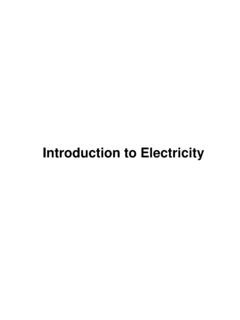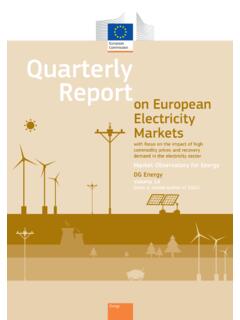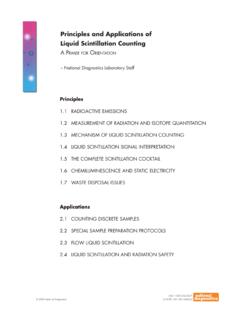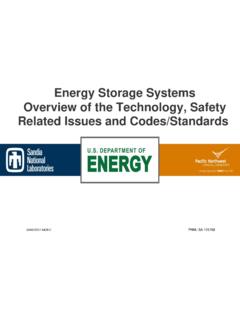Transcription of SS103 Electrical Fundamentals v2 - LennoxPROs.com
1 HVAC Essentials Series Electrical Fundamentals Course SS103 Version 2011 HVAC Learning Solutions Page 1 of 73 Course SS103 Electrical Fundamentals HVAC Essentials Series Electrical Fundamentals Course SS103 Version 2013 HVAC Learning Solutions Page 2 of 73 Table of Contents 1. Introduction to electricity .. 4 Atomic Theory of Matter and electricity .. 4 How electricity Is Produced .. 5 Conductors and Insulators of electricity .. 6 Electric Potential (Voltage) .. 7 Current Flow (Amperage) .. 7 Resistance (Opposition to Current Flow) .. 8 Wattage (Electric Power) .. 8 Ohm's Law .. 8 Watt s Law .. 11 Review .. 13 Review Questions .. 15 2. Electrical Circuits .. 19 Electrical Circuit Basics .. 19 Source Voltage .. 20 Series Circuits .. 21 Parallel Circuits .. 25 Series-Parallel or Combination Circuits .. 29 Wiring Diagrams.
2 29 Review .. 31 Review Questions .. 33 3. Switches .. 37 Single Pole, Single Throw ( ) Switch .. 37 Double Pole, Single Throw ( ) Switch .. 38 Single Pole, Double Throw ( ) Switch .. 38 Double Pole, Double Throw ( ) Switch .. 38 "Need to Know Information" Concerning Switches .. 39 Other Types of Switches .. 39 Thermostats .. 40 Pressure Switches .. 41 Flow 42 Fuses and Overloads .. 42 HVAC Essentials Series Electrical Fundamentals Course SS103 Version 2013 HVAC Learning Solutions Page 3 of 73 Other Symbols .. 43 4. Loads and 45 Solenoids .. 45 Heaters .. 45 Low Voltage Signal Lights .. 46 Magnetic Controllers .. 46 Transformers .. 50 24-Volt Wall Thermostats for Heating and Cooling Systems .. 52 24-Volt Circuits and Wiring Diagrams .. 53 Motors .. 55 5. Meters, Diagrams, and Troubleshooting .. 58 Volt Ohm Meters.
3 58 Amp Meters .. 59 Ohm Meters: "A Closer Look!" .. 60 Basic Troubleshooting Using a Volt Meter .. 63 Review .. 65 Review Questions .. 66 Appendix: Answers to Review Questions .. 72 Section 1 .. 72 Section 2 .. 72 Section 5 .. 72 HVAC Essentials Series Electrical Fundamentals Course SS103 Version 2013 HVAC Learning Solutions Page 4 of 73 1. Introduction to electricity The importance of electricity in our modern society is often taken for granted. Without electricity , the heating, cooling, and refrigeration industries would never have advanced beyond ice, saw dust, and the wooden locker. This industry relies on electricity to power and control the components that maintain comfort in our homes and offices. It is for this reason that service technicians need to understand the principles of electricity and be able to troubleshoot these circuits. To begin the study, we ll start with atomic structure.
4 Atomic Theory of Matter and electricity All matter in the universe is composed of elements. To date, over 100 elements have been found in our universe. To break down the elements, we must look at the atom, which is the smallest particle of an element that can exist alone or in combination with others. The center of an atom is the core or nucleus. The nucleus is composed of protons, which are positively charged particles, and neutrons, which are neither positively nor negatively charged. Atoms of the same element always have the same number of protons (called the atomic number), but the number of neutrons can vary with different atoms of the element. Atoms than contain a different number of protons and neutrons are called isotopes of the element. The other part of the atom is composed of electrons, negatively charged, which orbit the nucleus, very much like our moon orbits the earth.
5 Usually atoms have an equal number of protons and electrons. When this is true, the atom is considered electrically neutral. Under certain conditions, however, either gaining or losing an electron can unbalance an atom. When this occurs an atom can become either negatively or positively charged. HVAC Essentials Series Electrical Fundamentals Course SS103 Version 2013 HVAC Learning Solutions Page 5 of 73 Metal's atomic structure has electrons that can easily be "knocked out of their orbits" around the nucleus. These free electrons and the materials (metals) are called conductors. When an atom loses its electrons, it becomes unbalanced and contains a positive charge. When this occurs the atom can easily attract and acquire additional electrons; this makes the atom negatively charged. When this alternating state of positively then negatively charged particles exists, electrons can flow between the two opposing atoms.
6 This flow of electrons is Electrical energy or electricity . How electricity Is Produced The movement of electrons or, as we refer to it, a "flow of electrons" is accomplished in several ways. The means most commonly related to HVAC will be discussed here. Chemical A battery produces a flow of electrons by a chemical reaction between two electrodes within the battery. Electrodes by definition are "solid conductors through which an electric current can pass." One electrode in a battery "gives up" the electrons whereas the other electrode "collects" the electrons. The electrodes are constructed of dissimilar metals. When encased within an electrolyte, such as an acid or paste, electricity is produced by the chemical reactions of the electrolyte and conductors. Batteries produce Direct Current (DC), which is electron flow in one direction only. Magnetic Induction or electricity by Magnetism Magnetic Induction is the most widely used form of electricity generation.
7 This is accomplished by rotating magnets within a coil of wire, whereby the lines of force within the coil cause an alternating current (AC) to flow within the wire. These magnets break the lines of force within the coils of wire and induce alternating current (AC) to be produced. This method of Electrical generation is what powers our homes, our offices, and the heating and air conditioning equipment that maintains our comfort. HVAC Essentials Series Electrical Fundamentals Course SS103 Version 2013 HVAC Learning Solutions Page 6 of 73 Heat If two dissimilar metals are joined together at one end and their junction is heated, a small amount of voltage will be produced. The heat from the pilot flame is the source of heat that causes the thermocouple to create a small amount of DC voltage. This DC voltage of approximately 30 mv (millivolts) energizes the small coil in the gas valve (pilot valve), holding the pilot valve open to allow gas to flow.
8 If the flame for any reason is blown out, the heat will be removed from the thermocouple, causing the pilot valve to close. Conductors and Insulators of electricity The movement of free electrons from one atom to another is facilitated by the characteristics of a good conductor. Most metals are conductors of electricity , but all metals do not conduct electricity equally. Metals that are good Electrical conductors are copper, aluminum, and silver. Copper is most widely used because of its lower cost. Silver is a better conducting metal but is most often used only on the surface of contacts in switching devices such as relays or motor starters (contactors) because of its much higher cost. Insulators are materials that do not easily give up or "take-on" free electrons. Examples of insulators are glass and rubber. How well any insulator works is directly dependent upon the strength of the Electrical potential applied in other words, how high the voltage value is.
9 No matter how good an insulator is, certain conditions can exist whereby an insulator will fail. If the Electrical potential exceeds the insulating characteristics of the insulator or the amount of current exceeds the rating of the conductor, the insulator will fail due to high pressure or high heat, respectively. The importance of conductors and insulators cannot be understated. Without good conductors or insulators, the circuits necessary to operate and control the components of an HVAC system could not exist. HVAC Essentials Series Electrical Fundamentals Course SS103 Version 2013 HVAC Learning Solutions Page 7 of 73 Electric Potential (Voltage) Voltage (represented with the symbol E ) is the pressure behind electron flow. Naturally if there is no pressure, there is no reason for electrons to move. The volt measures the pressure of electricity . Keep in mind that pressure alone does not indicate the total amount of energy being used.
10 Just as with a water pipe, you can have pressure without flow when it is turned off. Everyone has experienced a drop in water pressure when additional faucets are opened. The same concept can be applied with electricity when the demand of usage exceeds the capabilities of the incoming supply. Sometimes when a large load starts, the lights will dim for a second. The pressure (voltage) of electricity is dropping when this occurs. Systems that run on a higher voltage level have the capability of using more total energy because of the higher pressure, but the usage is determined by the load doing the work. Current Flow (Amperage) Amperage (represented with the symbol I ) measures the flow of electrons and is referred to as current. In order for the current to flow, there must be a complete path from the power source to the load and back. These pathways for electricity are called circuits.









